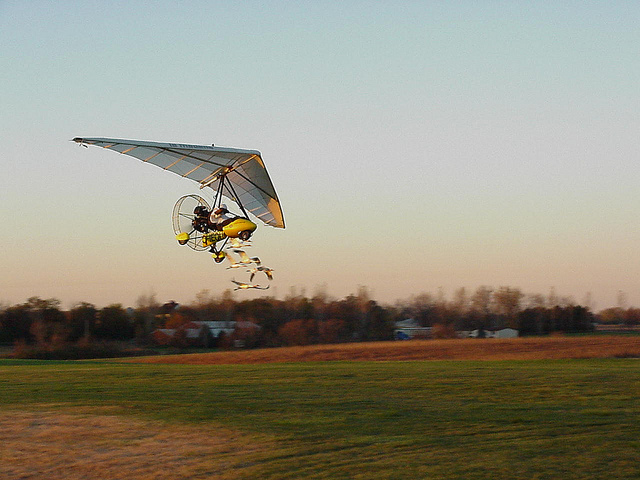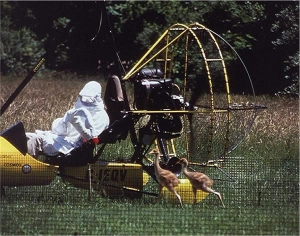A new chapter for whooping cranes opens today, as Operation Migration’s last and final ultralight-led migration wrapped up in Florida yesterday. For OM, and its six young Class of 2015 whoopers, this has been the longest migration ever. As with the fourteen that preceded this one, it has had its own stories and dramas that define it.
The unexpected ending of this particular migration – finally boxing up the birds just 25 miles short of their winter pensite at St. Mark’s National Wildlife Refuge – might seem an ignoble exit strategy, but not really. It was a necessary strategy demanding extra-stiff-upper-lip-heroics from the crew that loved and lived and flew with the birds. It was just one more small detail in the drama of reintroducing an endangered species, long absent, from a particular landscape. And it was a necessity so that things could move along to the next necessary step.

This is a sight that people in Tallahassee had hoped to see one more time. Photographer and Citizen Scientist, Karen Willes, made this lovely photo of the arrival of the Class of 2014 over the town of St. Marks, in December a year ago. Ultralight pilot Brooke Pennypacker had two of the seven cranes “locked” to each wingtip. (Photo used with permission)
The prepared pensite was waiting for them at St. Marks, and there were people from Tallahassee and all over the region hoping to get a glimpse of the cranes and ultralights flying overhead. But mostly, for the birds, there was the calendar, saying “it’s February!” The birds needed to be at home in the wetland pen where they are lightly monitored, and they will learn a few things about life on their own in preparation for their NEXT migration: their first independent flight north to Wisconsin. That migration will begin sometime in March, or possibly, April.
You can totally immerse yourself in more of the drama of this story at The Operation Migration Field Journal. Look especially at the posts where OM’s gifted pilots turn into gifted writers, as well. This is where you’ll learn from Brooke’s long musing report of his last flight (Day 102 . . . The Last Waltz) that “denial” is really just “hope spelled backwards.” (Who could not say ‘Amen!’ to that?)
You can learn about the competitive, not-really-a-team-player bird, #2-15, in Driving Miss Crazy. Or Joe’s description of clearing the trees at the end of the runway last Saturday, only to have his ultralight turned sideways by a blast of wind, and a few more thoughts about the conclusion of his avian aviator career – one of the world’s most unique job titles.

This older file photo depicts an ultralight training flight at Necedah National Wildlife Refuge. (Photo courtesy of WCEP)
And read today’s post from Heather, “Carry On . . .” explaining how she joined up with OM 18 years ago, and began to post online about the work; how soon after people began following, and thus, “Craniacs were born!” And her final tribute to the reason for it all:
” . . .Whooping cranes – Regal. Noble. Majestic. Magnificent. Fly free my feathered friends. Live long. . .” she wrote.
Like all good stories, the new chapter for whooping cranes will begin with dozens of pressing questions. Like these: Without ultralight flights, what IS Operation Migration’s new contribution to the effort? What kind of future is there for the 100 whooping cranes in the eastern flyway stretching from Wisconsin to Florida? Will the Whooping Crane Eastern Partnership (WCEP) hold? Will WCEP continue to track and monitor these birds?
And: What happens now to the costume-rearing technique? What IS really known about these Wisconsin whoopers’ so-called “lack of parenting skills?” Will the hundreds – no, thousands, probably – of craniacs spontaneously created as a byproduct of this project, remain tuned in? Where are the two new wild whooper families now? The ones that were sighted by Wisconsin birders repeatedly last fall at Necedah NWR?

This is the way young whooping cranes have been trained in Wisconsin to fly with ultralights and learn a migration route from 2001 through 2015. (Paul K. Cascio photographer, USGS Multimedia Gallery)
And, for that matter, just what IS going on with the weather – and is it “weather” or is it “climate?” – the thing that seems to have grounded flight after flight this year; and last year too, come to think of it? And, oh, by the way, what about the Whooping Crane Festival? Will there be one again in Princeton, Wisconsin, come September?
So many questions today! And these are the building blocks of tomorrow’s stories, waiting to be told.










